The Dynamic Control of Colors
By John Palka — Posted November 22, 2020
Autumn is a season of transition and it can be spectacular. Just a few weeks ago, the brilliant leaves we all love so much were everywhere, like at this jewel-like pond on the North Shore of Lake Superior.
Or here in the woods of the Eastman Nature Center near our house on the outskirts of Minneapolis.
The Canada geese have arrived from further north.

More than anything, autumn is the season of brilliant colors, and most of us are immediately drawn to them. However, as much as we relish them, the colors can also prompt us to ponder. In one of the earliest posts on Nature’s Depths, “Our Brightly Colored World” (November 29, 2015), almost exactly five years ago, we asked, where do colors come from and how do we get to see them? Let’s look at that question again now, and then take it further.
PIGMENT MOLECULES
Here is a basic explanation of why pigment molecules lend color to the materials of which they are a part. When light strikes a molecule, it interacts with it. The nature of that interaction depends jointly on the structure of the molecule and the wavelength of the light.
- In the ultraviolet range—at wavelengths that are somewhat too short to be visible to us but are visible to insects—the high energy of the light can damage or even break apart many molecules. This is why it is so dangerous to be exposed to sunlight at high elevations—there the sunlight is richer in UV than it is at ground level and therefore potentially more dangerous to the molecules in our eyes and our skin.
- Just beyond the other end of the visible spectrum, where the wavelengths are long, infrared illumination agitates molecules. That’s how heat lamps work. Infrared makes molecules move more and molecular movement is what constitutes heat. With more heat, the temperature goes up and our temperature-sensing nerve endings detect that elevated temperature.
In between ultraviolet and infrared, we get color. For example, chlorophyll molecules make leaves look green. This is because the middle wavelengths of light, the ones that we perceive as green, pass though the chlorophyll and remain available to our eyes, whereas those in the red and blue regions of the spectrum are absorbed. Light, of course, is a form of energy, so the energy carried by the absorbed red and blue wavelengths is transferred to the chlorophyll molecules. These molecules are linked with a large number of other molecules, and the whole array, ultimately, uses the absorbed solar energy to drive the biosynthesis of sugar. The energy of nuclear reactions in the Sun, reaching the Earth in the form of light, is thus used to drive the synthesis of sugar molecules and is stored in them. These sugar molecules support virtually all of life on Earth. And how do we ourselves get to recognize that leaves are green and not blue? Check out the post “Seeing Colors” (December 13, 2015) and find out!
This basic process applies to all pigment molecules. Blue pigments transmit blue light but absorb red, green, and yellow. Red pigments transmit red wavelengths but absorb yellow, green, and blue. And so forth. The unabsorbed wavelengths reach our eyes either directly (as when pigment molecules are in a clear solution) or by reflection (as when they are painted on a canvas or embedded in a solid material.
Now, let’s take several further steps:
- We know that different pigments have different molecular structures.
- These structures are what determines which wavelengths of light they absorb and which they allow to pass through.
- Each molecular structure is synthesized via particular biochemical reactions.
- Different biochemical reactions are facilitated by different enzymes.
- And different enzymes are encoded by different genes.
By this sequence of steps, a cell’s genes give that cell its specific pigments. This affects the coloration of an animal, or a flower, or a leaf, and thereby it also affects that life form’s place in the ecosystem. Photosynthesis, pollination, mate attraction, camouflage, and many other functions are affected by color. It’s an exhilarating set of interconnections, isn’t it—from genes to pigments to interaction with sunlight and on to survival, reproduction, and, in the long run, evolution!
There is, however, a conundrum.
SAME GENES, DIFFERENT COLORS
The golden and red leaves we love so much used to be green. This means that the same cells, with the same genes, are producing a different set of pigments in the fall than they did in the summer (see “Flaming Forests” posted on December 11, 2016). We can also readily see that not all the cells of an organism are the same color at any one time. Nevertheless, their genetic makeup hasn’t changed from that of the fertilized egg from which the organism developed. Given the sequence of steps we just went through, how can this be? If all cells in an organism carry the same genes, the genes encode enzymes, the enzymes drive specific biochemical reactions, those specific reactions yield specific pigment molecules, and specific pigments yield specific colors, how can one cell of an organism produce different colors at different times? Or be of a different color than another cell of the same organism? We’ll use monarch butterflies (Danaus plexippus, Family Nymphalidae, Sub-Family Danaidae) to approach this question.
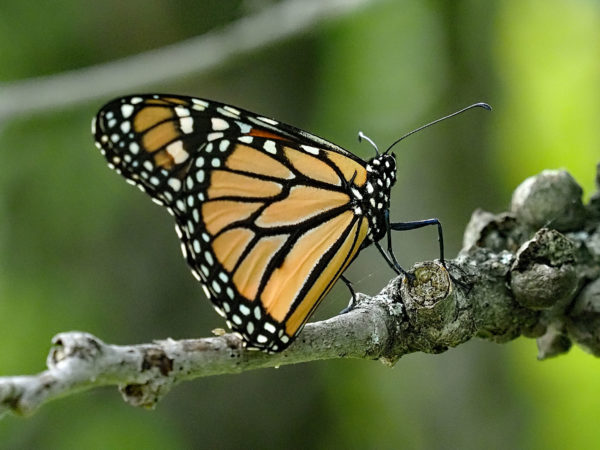
In the post “The Magic of Butterfly Wings” (June 4, 2017) we noted that the colors of butterfly wings are the properties of tiny, individual scales produced by single cells. Below are two pictures of the edge of a monarch’s wing to show this. In the first picture you can see that the surface of the wing is highly structured, not smooth the way it looks to the naked eye, even from quite close. The extremely regular rows running left-right across the orange, black and white areas are rows of scales. 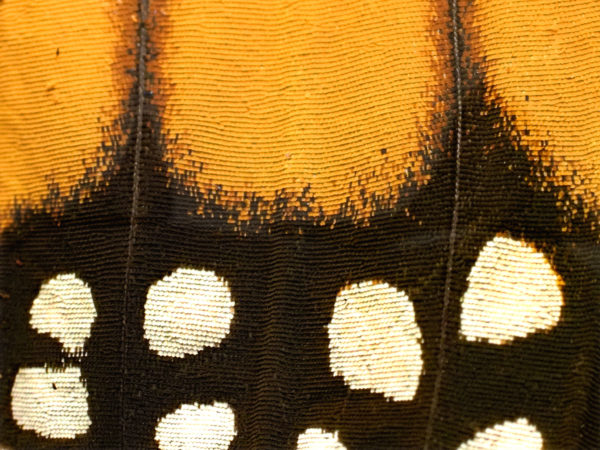
Individual scales are more evident in the next picture, taken in the same location but at higher magnification. The white patch in the lower left shows the scales most clearly. Along the lower margin of each scale you can just detect the stalk on which it is set. There is also a single detached scale, orange and oriented diagonally, slightly to left of center.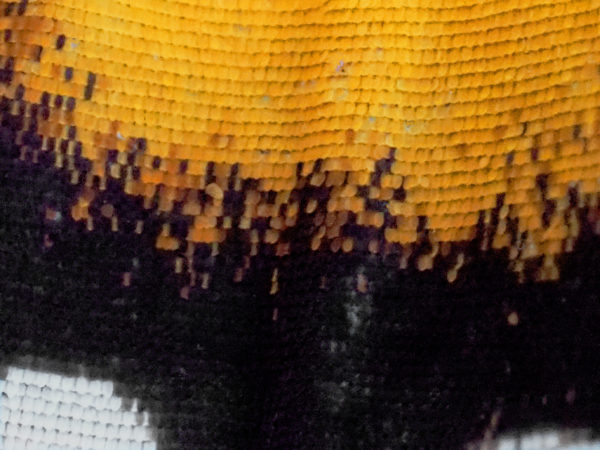
Neighboring scales can be of the same color, but they can also be of different colors. This is our question. How can you have two scales side by side, each produced by a single cell, but one of them black and the other orange? How does a developing butterfly arrange to deposit exclusively black pigment in one scale and exclusively orange pigment in its neighbor? How might we explain this, given that all of the cells of an individual butterfly have the same genes?
The basic answer is gene regulation.
GENE REGULATION
The overall framework of the explanation for the “same genes-different colors conundrum” is this: the fact that a gene is present in a given cell does not automatically mean that it is active. Genes are designed—have evolved to be—regulated. They can be maximally turned on, or completely turned off, or can function at some intermediate level of activity. Portions of a gene’s DNA, or segments of the DNA immediately adjacent to the gene itself, or proteins associated with the gene have an architecture that invites the binding of molecules whose function is to regulate that gene’s activity. The activity of any given gene can be adjusted depending on circumstances. In this way a cell can, for example, respond to hormones and its functioning can be tied to maturation or to a changing environment as we have seen in the case of leaves ( “Flaming Forests”). A cell’s genes, and hence the cell itself, can also respond to molecules that function in processes that recruit cells into structures and patterns, such as the beautiful patterns on butterfly wings.
Here is an example of how this works. In the pair of pictures just below, the upper one is of a purplish fritillary (Boloria chariclea, Family Nymphalidae) taken on Hurricane Ridge in Olympic National Park. The lower picture is of a monarch taken at the Crow-Hassan Nature Reserve in Minnesota. These butterflies are evolutionarily related and belong to the same family, Family Nymphalidae. 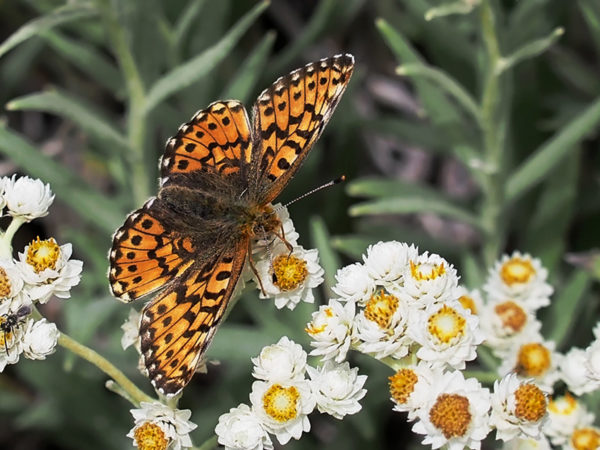
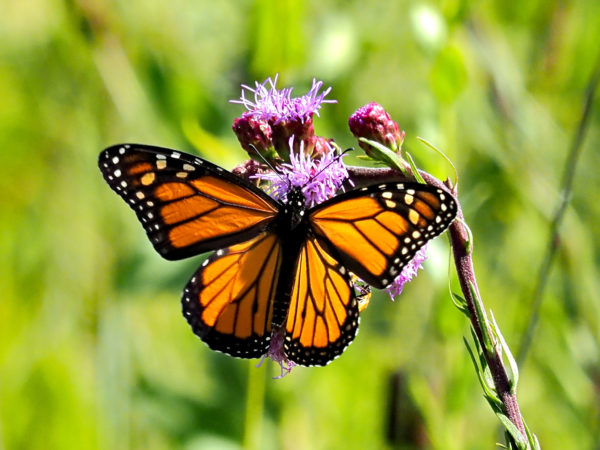
The color palette of their wings is very similar. Given this similarity, as well as the overall relatedness of the two species, the genes that govern the synthesis of pigments by the scale cells of their wings are probably the same. However, the mechanisms that generate patterns on the wings give conspicuously different results. A reasonable hypothesis would be that the genes governing the pattern-generating mechanisms are in some way different in fritillaries and in monarchs and the differences reflect the operation of evolution.
Here are two more examples. The pine white (Neophasia menapia, Family Pieridae) in the upper of the next two pictures and the red admiral (Vanessa atalanta, once again Family Nymphalidae) in the lower one differ both from the fritillary and from the monarch. They also differ markedly from each other.
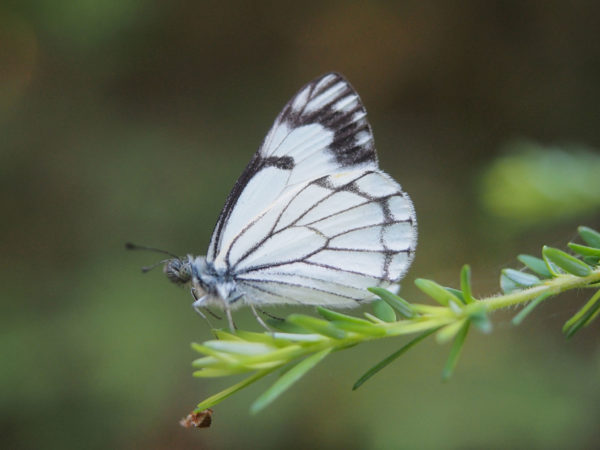

All four species show black and white on their wings and three out of the four also produce orange. Therefore, the genes required for the synthesis of wing pigments are probably largely the same across these species. The patterns, however, differ in many ways, so we can expect differences in the genes that guide the development of patterns: the genes that encode the enzymes that construct the molecules that participate in generating patterns are presumably different in functionally important ways across all four species.
THE PARABLE OF THE BLACK SWALLOWTAIL
Let me close with a remarkable story. One of the most familiar butterflies in America is the tiger swallowtail. There are two closely related species, the western tiger (Papilio rutulus, Family Papilionidae) and the eastern tiger (Papilio glaucus). Here is a picture of a male eastern tiger, taken at the Minnesota Landscape Arboretum.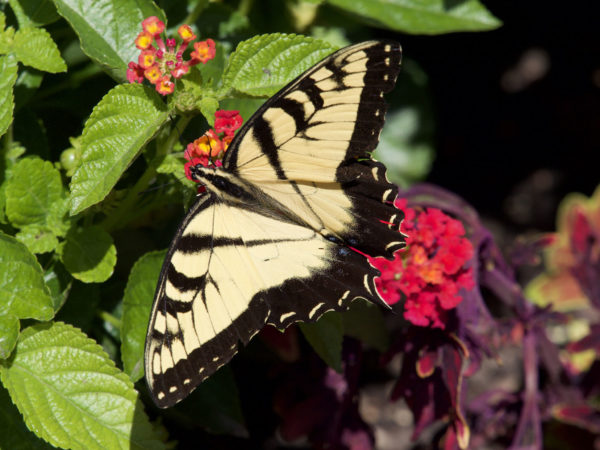
A female would look similar, except she would have considerably more iridescent blue on her hind wings. But there is another version of the female of this species, a black version or morph. Below is a picture of such a female, taken while she was feeding just a few feet away from the male shown above. It was late in the summer and she’d become rather battered, but the message is clear. Whereas the wings of many eastern tiger females are just like the wings of the males, golden with four black stripes, there are also many females whose wings are black all over except for the iridescent blue areas at the back and some small spots. This condition is referred to as melanism, because the black color is due to melanin. Melanin is a widely distributed group of closely related pigments that in mammals (including humans) cause dark coloration in hair, skin and behind the retina of the eye, and also tanning in sunlight. Melanins occur in a huge variety of organisms including even plants. We saw another example early in this post—the blacks and grays of the feathers of the Canada geese currently paddling on our lakes. 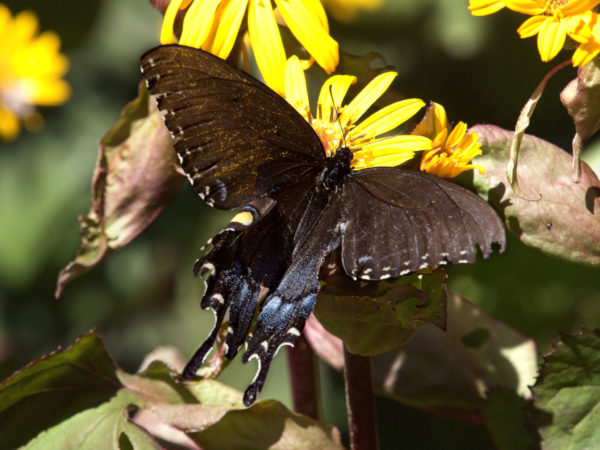
Biologists believe that the mechanism that leads to the presence of two such different morphs within a single species is also gene regulation. Here is part of the evidence.
- The pigment melanin makes the scales produced by single cells black. A set of pigments called papiliochromes (because, unlike melanin, they are special to the butterfly family Papilionidae) make the scales golden.
- It takes multiple biochemical steps to synthesize both melanin and papiliochromes.
- However, the initial biosynthetic steps for the two pigments are the same.
- A single compound in this shared pathway is the precursor of both pigments.
- A specific enzyme is required for making papiliochromes out of this shared precursor, but it is not needed for making melanin out of the same precursor. If that enzyme is lacking, papiliochromes are not made but melanin is.
- The enzyme is indeed lacking in black females.
- This implies that in black females, the gene encoding this crucial enzyme has been shut down—the regulation of a single gene has converted golden wings with black stripes into black wings!
This is not the whole story by any means. It is, however, a great example of how the regulation (in this case the shutting down) of a single gene—a gene that is still present and could in principle be turned on again—can play a central role in the generation of a visible pattern.
PULLING IT ALL TOGETHER
Today we have been on a journey that is more complex than usual, so let us review the material we have gone over. The basic ideas are these:
- The colors we see in the world around us are mostly due to pigments (though not entirely, because there are also so-called structural colors).
- Pigments are molecules.
- Each type of pigment molecule interacts with light in a specific way, absorbing some wavelengths and transmitting others. By separating the Sun’s spectrum in this way, colors are produced.
- Pigment molecules are usually rather complex and are synthesized through the action of enzymes.
- Enzymes are proteins whose structure is encoded in genes. One gene encodes one enzyme. (Genes, however, also encode molecules that are not enzymes.)
- The functioning of genes, including those that do encode enzymes, is under elaborate and highly specific control.
- The control of gene function is the most basic mechanism that allows the cells of a single organism, all of which carry the same genes, to become different from one another.
- The control of gene function also plays a central role in the mechanisms that cause cells to assemble into structures and to form patterns. Form and pattern-regulating genes exert their effects by regulating the genes of other cells.
- Like genes themselves, gene-regulating mechanisms have evolved and are part of an organism’s genetic inheritance.
Isn’t Nature amazing! When you go out to savor it, consider saying thank you for living in a world, and indeed a universe, that permits the evolution of molecular mechanisms that underlie not only life itself but also the complexity, variety and beauty of all living things, whether leaves or butterflies or human beings.
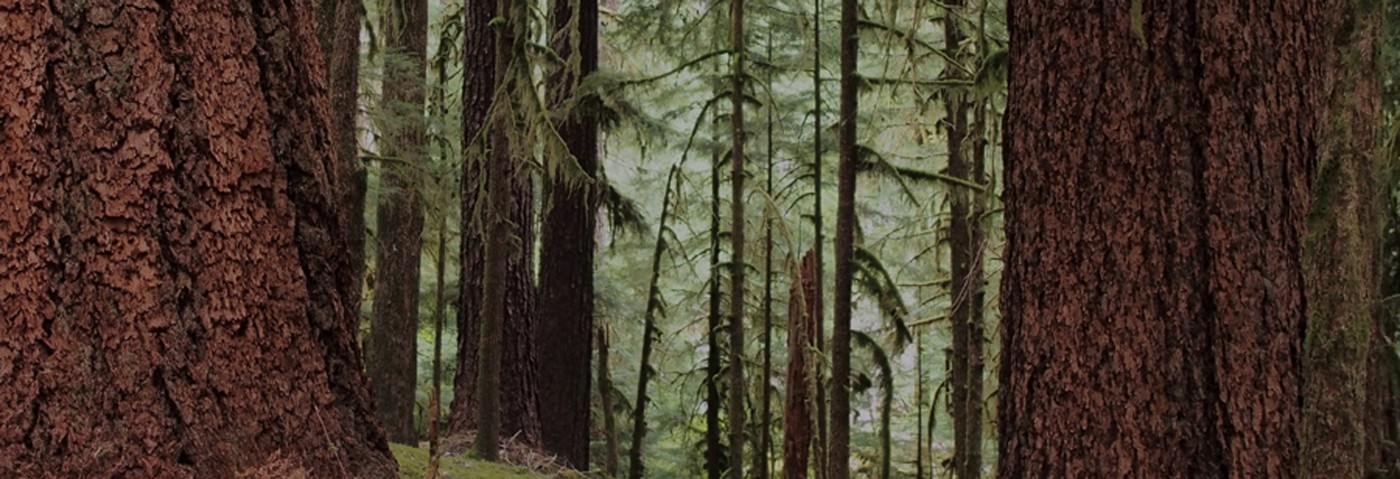
Very fascinating. I always learn something. I thought the color was reflection, not transmission, but I am now wiser. I am curious if the dark morph characteristic is inherited. I can imagine it being a difference in the DNA coding for proteins or in the environment or DNA that does not code for proteins but perhaps is switching off specific protein production? Life is so diverse and complex at all levels. THANK YOU!
Thanks, Marc. A lot of work has been done on the genetics underlying the black female morphs of swallowtails. I’m just starting to dig into the literature and will respond in more detail when I know more!
John,
Thank you for this post on the chemical and genetic control of color in nature! I really like the way you tied together the leaf and butterfly wing color schemes. The North Shore pond picture is gorgeous.
And ever since I was a butterfly-collecting grade schooler, I wondered how the female Tiger Swallowtails could have two such different morphs. I would now guess that gene regulation mechanisms account for dragonfly and damselfly heteromorphs.
You are in good company, Brian. Many biologists have wondered the same thing and have worked hard to try to understand how there could be such different morphs, especially in the many cases in which that only happens in females. As I wrote to Marc, I am now starting to dig into the recent literature. One of the things I came to appreciate extra clearly as I was writing this post is this – the mechanisms of gene regulation are themselves founded on the operation of genes and have themselves been subject to evolution. Thus, the action of genes and the regulation of gene action are aspects of the same overall picture of how Nature works.
excellent as usual
Thank you, Ursula!
The design & complexity of what you so ably described lead me to conclude that the random processes of evolution could not possibly have produced them. You mentioned design – I have to believe that design implies the existence of a Designer. In the beginning God created the heavens & the earth & all that are in them. We are mere discoverers of His marvelous creation & its intricacies & laws.
Here’s how I think about this big question, Cheryl. It is misleading to think of evolution itself as being a random process. Rather, it is a highly guided process. What is the source of the guidance? Natural selection. In order for natural selection to operate there has to be variation – some versions of an organism have to be better able to survive and reproduce than other versions of the same organism – and that variation is underlain by mechanisms at least some of which are indeed random. However, the selection of the most successful version, repeated generation after generation for literally millions of generations, has yielded the extraordinary organisms that we know today. Selection carried out by farmers has given us all the varieties of the foods we eat. Similar processes are being used today to select, for example, molecules that will be increasingly effective drugs. Rather than trying to design such molecules, scientists are inducing random variation and selecting new versions from that. What you formulate very beautifully has long been called the “Argument from Design.” We biologists generally do not accept that it is a strong argument. Rather, we base our thinking on evolution understood as a process guided by natural selection. However, many biologists and other scientists are also religious and do not see a conflict between believing in a God who lies behind the reality of our experience and the operation of evolution. Two of the best known such scientists in the world of Christianity are Francis Collins, the director of the National Institutes of Health and the man who led the whole Human Genome Project of the NIH, and John Polkinghorne, one of Britain’s greatest mathematical physicists, who left a highly distinguished chair at Cambridge University to become an Anglican priest. I would never try to dissuade you from the understanding you obviously cherish. I would, however, urge you to think a bit more deeply about how scientists understand the operation of evolution, and especially not to think of it as a random process. Please remember that the core idea is “evolution by natural selection,” not the haphazard appearance of the totally amazing creatures we find on our Earth and are ourselves!
Despite your warning that this post would be technical I decided to go ahead because, in the 70s, I came to hear of the dipole moment of molecules leading to their ability to absorb/reflect certain wavelengths and the ability to act as a solvent. Your post was very communicative for anyone stirred by curiosity.
I used to wonder how the body regenerates that particular tissue where a limb is injured. For example an injury to the hand would need specific skin replacement for the palm and other parts. It is wonderful to have a glimpse of the process and principles, even if the understanding is not deep enough.
In your response to a comment on “Design” you deftly moved on to selection by trial and error. Underlying even this is some WILL to survive and so to reject and select. That Will should be the same for all at an instictual level.. What then gives direction to Evolution into ‘higher’ life forms?
Look forward to hearing from you.
Regards
RSV SUBRAMANIAN
Biologists have not taken the question of the evolution of complexity lightly – it has been a subject of intense exploration and debate ever since Darwin’s time and continues to be so. One approach has these two components. (a) Variation is inescapably accompanied by natural selection. The fitter (better matched to the environment) organism is automatically more likely to survive and to reproduce than the less fit one. No “will” is required. (b) Complexity increases over time in some organisms but by no means in all. In fact, the vast, vast majority of organisms on Earth are still as simple as they were millions and even billions of years ago. Different yes, but not notably more complex. This includes the bacteria and other protists whose numbers exceed those of mammals and humans by many orders of magnitude. We pay more attention to the complex organisms than to the simple ones that we can’t even see, but that’s an incomplete picture of the real world. The point is that increased complexity is one of the possible outcomes of natural selection but it is not the only one.
The explanation most often given for why increased complexity ever provides a selective advantage is that it permits the specialization of body components. If you have a kidney, you can provide all of your cells with a more supportive chemical environment than if they all have to cope with variations in salt concentration or pH on their own. If you have fifty muscles in your fingers, you can control those fingers more precisely than if you have only ten muscles. And so on and so forth.
None of this, of course, precludes other perspectives, and indeed other perspectives have been offered within biology as well as other domains of thought. It does, however, provide a reasonable explanation of how the complexity we see could have evolved without any external guidance, or will of any kind, and thereby it removes the necessity of invoking such non-biological or non-physical factors. Perhaps they are there, but the biological/chemical observations and theories we have provide a plausible and adequate accounting for what we know about the material world.